We’ve all had to deal with it – the dreaded task of cleaning the toilet! Whether it’s no longer sparkling white, has hard water deposits, or just smells awful, toilets can be a challenge to clean.
With so many commercial products available on the market promising quick and easy results, you may not have thought about using something more natural like hydrogen peroxide to take care of your dirty bathroom business.
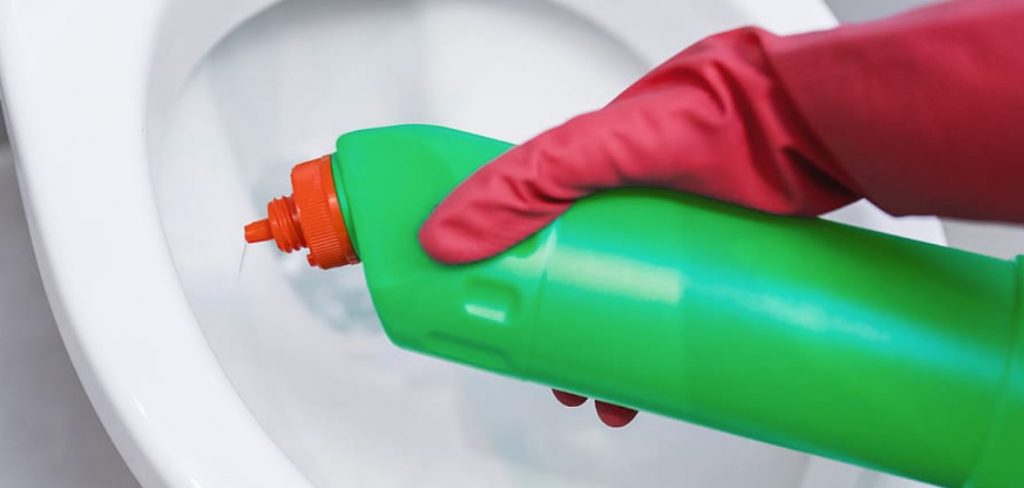
However, it turns out that hydrogen peroxide is one of the best solutions for cleaning those forgetful areas in an efficient manner while also being eco-friendly at the same time. In this post, we’ll explore how to clean a toilet with hydrogen peroxide, and why it’s the perfect product for the job.
Supplies You Will Need to Clean a Toilet With Hydrogen Peroxide
- Hydrogen Peroxide
- Water
- Sponge or soft cloth/brush
- Rubber gloves (optional)
- Disposal bin or bucket (for any debris/dirt)
Step by Step Guidelines on How to Clean a Toilet With Hydrogen Peroxide
Step 1: Identify the Problem Areas
If possible, start by examining your toilet bowl for any signs of mold, mildew, or rust. If these are present, it is best to use a bleach specifically designed for killing germs and removing stains. Otherwise, hydrogen peroxide can be used with great success to clean up any dirt or mildew in the toilet bowl.
Step 2: Prepare the Solution
Mix a gallon of water with 1-2 cups of hydrogen peroxide, depending on how dirty your toilet is. For extra cleaning power, add a few drops of dishwashing liquid for better sudsing action. This will help to lift stubborn dirt, as well as ensure the hydrogen peroxide does its job. For preparing the solution, always wear rubber gloves.
Step 3: Apply the Solution
Using a sponge or soft cloth/brush, apply the hydrogen peroxide mixture directly onto the affected areas of your toilet bowl. Allow it to sit for several minutes before scrubbing it with a brush to loosen dirt and grime. Then, use a damp cloth to wipe away any excess solution and dirt. While applying the solution, use rubber gloves to protect your skin.
Step 4: Rinse and Reapply
Once you’ve scrubbed the affected areas, rinse the hydrogen peroxide mixture off with clean water. If you still notice dirt or grime in those areas, reapply the solution and allow it to sit for a few more minutes before scrubbing again. Once you’ve scrubbed a second time, rinse the hydrogen peroxide mixture off once more before drying with a clean towel.
Step 5: Dispose of Waste Properly
If you’ve removed any debris or dirt from the toilet bowl, make sure to dispose of it in a disposal bin or bucket. Never flush anything down the toilet that does not belong there. Disposing of waste properly helps to ensure that the toilet stays clean and functions optimally for a long time.
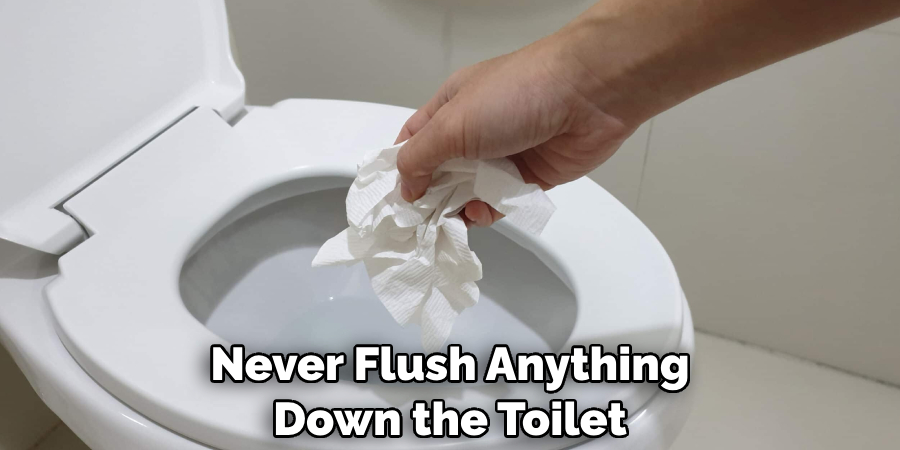
By following these simple steps, you can easily and quickly clean your toilet with hydrogen peroxide without having to use harsh chemicals or wait hours for results. Not only is it effective at cleaning tough dirt and grime, but it’s also eco-friendly. So next time you need to clean your toilet, try using hydrogen peroxide for quick and easy results.
Additional Tips and Tricks to Clean a Toilet With Hydrogen Peroxide
1. Mix a solution of one part hydrogen peroxide to one part water, and pour it into the toilet bowl. Let the mixture sit for 10 minutes before scrubbing it with a toilet brush. For stubborn stains, use an old toothbrush to scrub around the rim of the toilet bowl.
2. Create a paste from baking soda and hydrogen peroxide. Spread the paste around the inside of the toilet bowl and let it sit for a few hours before scrubbing with a toilet brush.
3. If your toilet is suffering from hard water stains, mix together equal parts white vinegar and hydrogen peroxide and pour it into the tank. Allow it to sit for 15 minutes, then flush the toilet.
4. To remove odors from your toilet, pour 1/3 cup of hydrogen peroxide into the bowl and let it sit for 10 minutes before flushing. Repeat this process if necessary.
5. Experiment with different ratios of hydrogen peroxide to water until you find a solution that works best for your needs. Some stains and odors may require more concentrated solutions. It can also be helpful to let the solution sit in the toilet for a longer period of time before scrubbing or flushing.
6. Avoid using hydrogen peroxide on colored toilets, as it may lead to fading or discoloration over time. Additionally, ensure that you clean any spilled hydrogen peroxide off of surrounding surfaces quickly, as it can damage them.
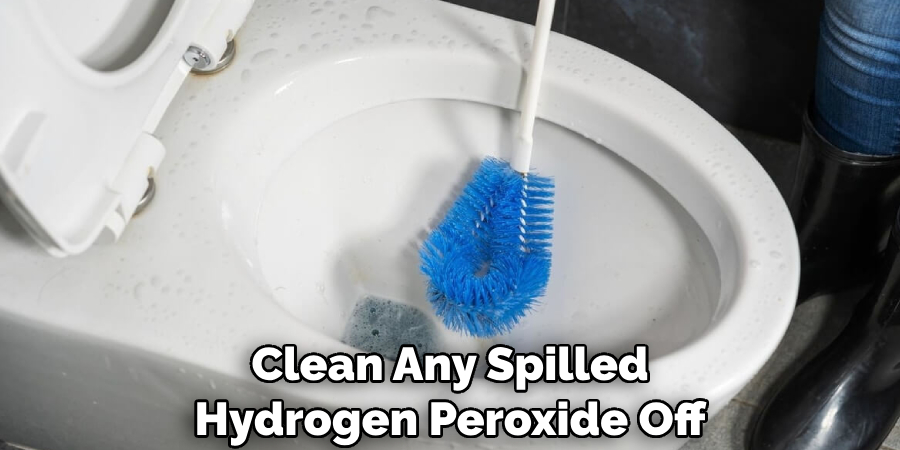
7. While cleaning your toilet with hydrogen peroxide is safe, make sure to wear protective gloves and open a window to allow for adequate ventilation. It is also advised to use goggles or eye protection when handling or spraying the solution in case of splashes.
By following these tips and tricks, you can easily clean your toilet with hydrogen peroxide for a safe and effective cleaning solution. Additionally, regular maintenance will help keep toilets looking their best for years to come.
Things You Should Consider to Clean a Toilet With Hydrogen Peroxide
1. Before starting the cleaning process, make sure that hydrogen peroxide is safe to use on your toilet and other fixtures. Some surfaces may react negatively with this cleaner.
2. Wear rubber gloves while cleaning as hydrogen peroxide can be an irritant for some people’s skin.
3. Make sure to pour a small amount of hydrogen peroxide into a spray bottle and test it on an inconspicuous area of the toilet first to ensure that it will not cause any damage.
4. Spray the hydrogen peroxide solution around the inside bowl, focusing on tough stains or areas with mold and mildew buildup.
5. Scrub the toilet with a brush to remove any stubborn spots and let the solution sit for a few minutes.
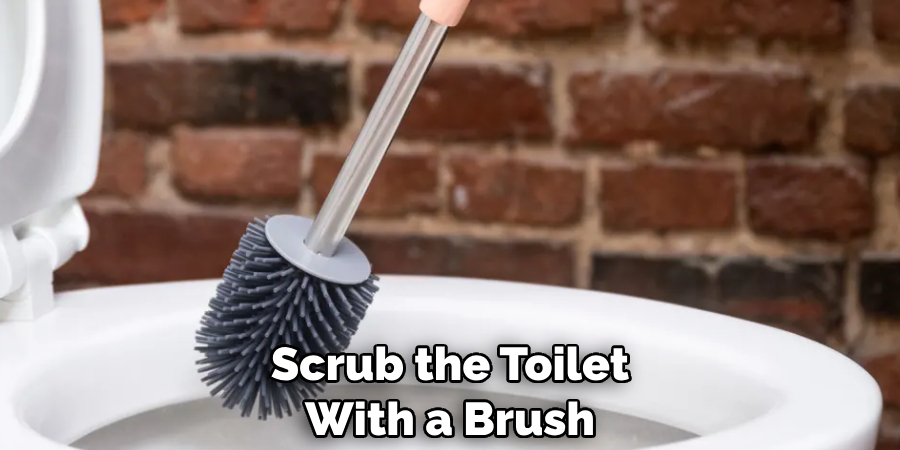
6. Flush the toilet and wipe down the outside of the bowl with a cloth dampened in hydrogen peroxide.
7. Rinse away any excess cleaner with warm water and dry the surface off with a soft cloth.
8. Pay special attention to the rim and handle of the toilet, as these areas are prone to collecting dirt and grime. Wipe them down with a damp cloth and hydrogen peroxide to remove any discoloration or residue.
By following these considerations to clean your toilet with hydrogen peroxide, you can keep your toilet looking and smelling fresh. And, because it is a natural disinfectant, you know that you are using a non-toxic cleaner that won’t harm the environment.
Precautions Need to Follow for Cleaning a Toilet With Hydrogen Peroxide
1. Wear rubber gloves to protect your hands before handling the hydrogen peroxide since it can be an irritant for skin contact.
2. Use a non-abrasive sponge or brush when cleaning with hydrogen peroxide as it is an oxidizing agent that can damage surfaces if used with abrasive material.
3. Avoid direct contact with the eyes since hydrogen peroxide can cause irritation and stinging if it comes into contact with the eyes.
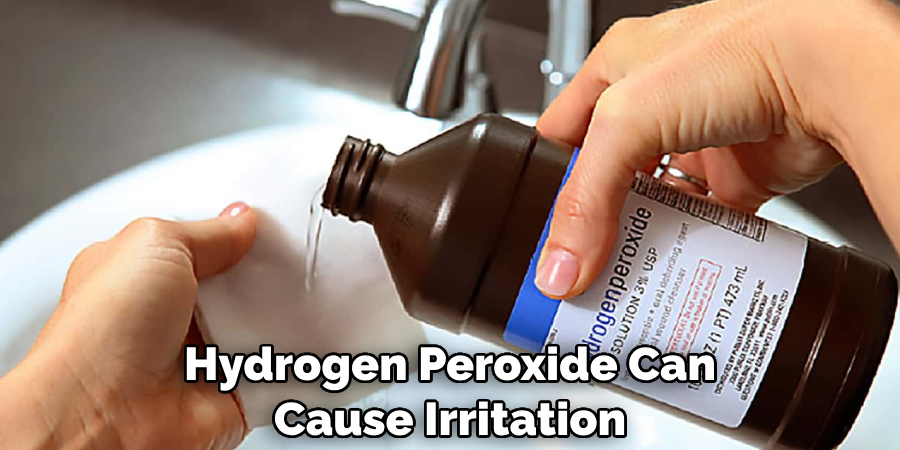
4. Also, make sure to keep any pets away from the toilet while cleaning it since hydrogen peroxide vapors can be dangerous for pets as well.
5. Finally, always remember to ventilate the bathroom while cleaning with hydrogen peroxide to reduce any risk of inhaling too much of its fumes. This can be done by keeping a window or fan open near the toilet while you’re cleaning.
Once finished, discard any remaining hydrogen peroxide in accordance with local laws and regulations. Be sure to store it safely away from children and pets.
By following these precautions, you can ensure that the process of cleaning your toilet with hydrogen peroxide goes smoothly and safely. You will have a sparkling clean and hygienic toilet without any risks to yourself or your home. Happy Cleaning!
Common Mistakes on How to Clean a Toilet With Hydrogen Peroxide
1. Using Too Much Hydrogen Peroxide:
Using more than the recommended amount of hydrogen peroxide can be corrosive and damage your toilet bowl. Be sure to stick to the recommended measurements when cleaning with hydrogen peroxide. If you have a particularly tough stain, you can use more hydrogen peroxide, but only after testing it in an inconspicuous area first.
2. Not Allowing Enough Contact Time:
Hydrogen peroxide needs to be left on the surface of the toilet for at least 10 minutes so that it has time to work its magic and break down the bacteria and dirt. This is especially true when dealing with tough stains, such as mineral deposits. So make sure to leave the peroxide on the surface of the toilet for at least 10 minutes before rinsing it off.
3. Not Rinsing with Water:
Once you’ve allowed enough contact time, be sure to rinse off the hydrogen peroxide with water. This will help prevent any potential damage that could be caused by leaving the peroxide on the surface of your toilet for too long. It will also help ensure that all of the bacteria and dirt are removed.
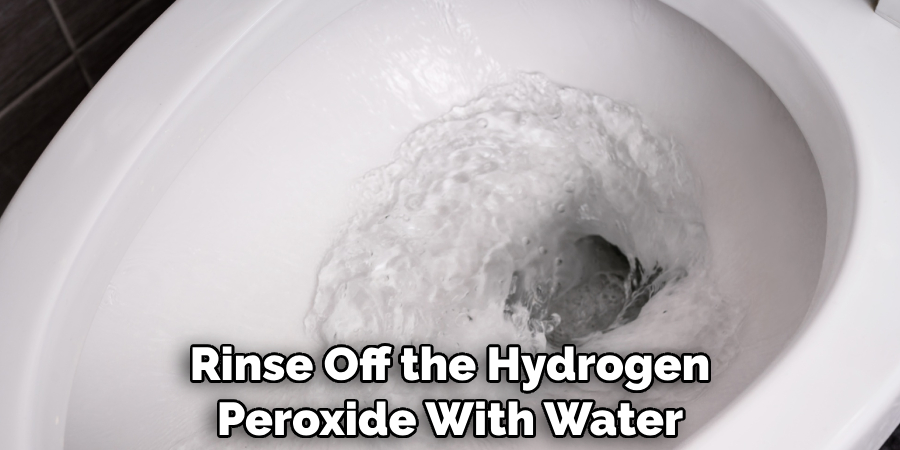
4. Not Wearing Gloves:
When cleaning with hydrogen peroxide, it’s important to wear gloves to protect your hands and skin from the strong chemicals in the solution. Therefore, be sure to put on a pair of rubber gloves before beginning the cleaning process. Gloves will also help protect your hands from any sharp objects that may be lurking in the toilet bowl.
By avoiding these common mistakes, you can ensure that cleaning your toilet with hydrogen peroxide is a safe and efficient process. You’ll have your cleanest and brightest-looking toilet in no time!
Frequently Asked Questions
How Much Hydrogen Peroxide Do I Need to Clean My Toilet?
It depends on the size of your toilet and how dirty it is. Generally, a half-cup of hydrogen peroxide should be enough for most toilets. However, you may want to use more or less depending on your needs.
How Do I Put the Hydrogen Peroxide in My Toilet?
Using a funnel, pour the hydrogen peroxide into your toilet bowl. Make sure you don’t accidentally splash any of it onto yourself or your clothing. Funnel it slowly and carefully in order to prevent any spills.
How Long Should I Let the Hydrogen Peroxide Sit in My Toilet Bowl?
It’s best to let the hydrogen peroxide sit for at least 15 minutes before scrubbing or flushing. This will give it enough time to work its way into all of the nooks and crannies of your toilet bowl.
Should I Wear Gloves When Cleaning My Toilet With Hydrogen Peroxide?
Yes, it’s always a good idea to wear gloves when cleaning with any kind of chemical, including hydrogen peroxide. This will help protect your skin from any irritation that could occur from contact with the chemical.
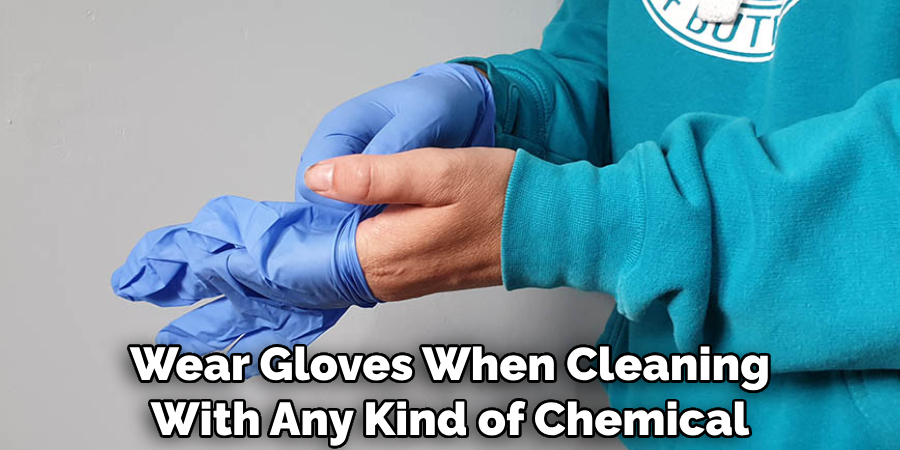
Is Hydrogen Peroxide Safe to Use in My Toilet?
Yes, hydrogen peroxide is a safe and effective way to clean your toilet. It’s non-toxic and won’t damage the surface of porcelain or other types of toilets. However, as with any cleaning chemical, it’s important to use caution and follow the instructions carefully.
Conclusion
To wrap it up, we’ve learned how to clean a toilet with hydrogen peroxide. Be sure to familiarize yourself with the proper precautionary measures when working with this material. If you invest the time and energy into this task, your toilet bowl should be greatly improved and gunk-free.
Don’t let a filthy toilet take away from the natural beauty of your home – enlist today’s convenient cleaning solutions so you can be proud of every corner of your residence!
Utilizing hydrogen peroxide ensures that not only will the job get done effectively, but also safely. So what are you waiting for? Take action now and start sanitizing tasks in a flash!